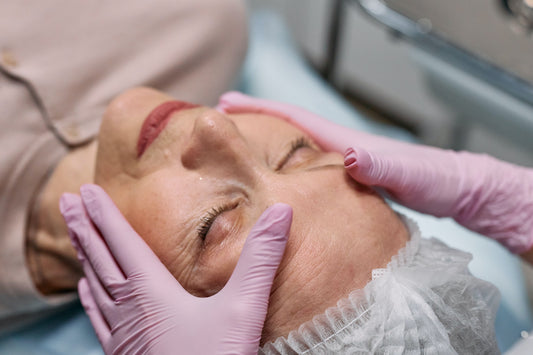Nitrile gloves are a type of hand protection made from a puncture-resistant and chemical-resistant material. Just like latex gloves, nitrile gloves start their production cycle as rubber from rubber trees. The rubber undergoes various cycles of production, including the removal of the proteins that cause latex allergies. At the end of the cycle, the rubber is transformed to nitrile and made into nitrile gloves. Nitrile gloves are basically a stronger version of latex gloves without latex allergens. Although latex gloves have their uses and are appropriate in certain situations, nitrile gloves can be used in almost any situation where latex gloves are used. Most people are used to latex gloves because they are familiar with them, as well as this kind being more commonly available; however, nitrile gloves are fast becoming the gloves of choice for many reasons.
Why Use Nitrile Gloves
- They are stronger and more durable than latex
High quality nitrile gloves are up to 3 times stronger than latex, which makes them more durable. Latex is made from natural rubber, which is limited in strength and thickness, while nitrile is made from nitrile butadiene rubber (NBR), which is man-made and can be fortified as needed. This quality allows nitrile gloves to come in many different sizes, thickness, and colors. NBR is found in so many other products we use, including sponges. With increased strength1, it is puncture-resistant2, and often medical grade, making them safer for use in many situations where you need that extra protection.
- They are latex-allergen free
Since nitrile gloves are made from inert compounds, they do not react with the skin or trigger allergies similar to latex gloves. This makes them a great substitute for latex gloves. Even if you are not allergic to latex and could use it without any problems, someone else who is allergic to latex can come in contact with it. With nitrile gloves, you take the guesswork out. Nitrile gloves are also BPA-free, MBT-free, Phthalate-free, vinyl-free, and often powder-free like the Aurelia Bold Black Gloves3.
- They are cost effective
Nitrile gloves are more rigorous to make as the rubber requires several manufacturing steps. When they first hit the market, they were significantly more expensive than latex gloves due to their manufacturing costs. However, with time and advancement in technology, nitrile gloves are now manufactured in a more cost-effectively way, making them competitively priced and more affordable.
- They are medical grade
Premium nitrile gloves are typically medical grade and can withstand use in almost every clinical setting. A clinical study4 comparing the effectiveness of nitrile gloves as a barrier to bloodborne pathogens and infectious pathogens showed that when compared to polyvinyl chloride (vinyl) gloves and latex gloves, nitrile gloves significantly outperformed vinyl gloves as a protective barrier after normal manipulation. The study also showed some residual latex-allergy-causing proteins in the latex gloves. The study concluded that nitrile gloves provided a medical grade protective barrier, had no leakage, and proved effective for protecting against exposure to biohazards or infectious pathogens.
- They are regulated
Just like other drugs and medical devices, the FDA regulates latex and nitrile gloves as medical devices and requires a premarket notification (510K)5 from manufacturers showing that the gloves are safe and effective – equivalent to similar legally marketed devices. That means that manufacturers of authentic and high-quality latex and nitrile gloves have to pass stringent requirements to make sure the gloves are safe and effective for medical use. According to the FDA, powdered gloves cannot legally be marketed6 in the USA for medical purposes; thus, medical grade gloves must be powder-free, such as the Black Nitrile PF Gloves7, or the Transform PF Gloves8, which are finger-textured, puncture-resistant, durable, ambidextrous, and latex-free.
References
Phalen, R.N., Wong K.W., Integrity of Disposable Nitrile Exam Gloves Exposed to Simulated Movement. J Occupational Environment Hygiene
https://www.ncbi.nlm.nih.gov/pmc/articles/PMC3124250/
Mylon Peter, Lewis, Roger., et al. A study of clinicians’ views on medical gloves and their effect on manual performance. American Journal of Infection Control.
https://www.ajicjournal.org/article/S0196-6553(13)01145-0/pdf
Aurelia Bold Black Gloves
https://grjhealth.com/collections/gloves/products/aurelia-bold-black-nitrile-glove
Rego, A., Roley, L. In-use barrier integrity of gloves: latex and nitrile superior to vinyl. American Journal of Infection Control
https://pubmed.ncbi.nlm.nih.gov/10511487/
Premarket Notification (510K)
https://www.fdahelp.us/premarket-submission-510k.html
FDA Registration – Latex and Nitrile Gloves
https://www.fdahelp.us/FDA-Registration-latex-nitrile-gloves.html
Aurelia Sonic Nitrile Gloves
https://grjhealth.com/collections/gloves/products/aurelia-sonic-nitrile-gloves
Aurelia Transform Nitrile PF Gloves











